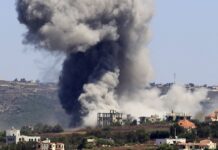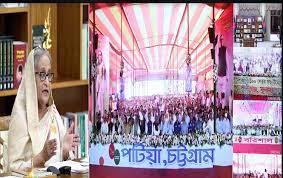Prime Minister Sheikh Hasina on November 7 inaugurated 100 bridges in 25 districts virtually from Ganobhaban. These bridges have freed the ferry service of 33 routes and established direct road connectivity to the respective places with the capital.
Bangladesh has undertaken extensive development plans over the past few decades, some of which have already been put into action and others of which are in various stages of completion, with the goal of joining Trans Asian Highways— Asian Highway and Asian Railways— to strengthen the nation’s international connectivity. The government’s efforts over the past few years, which have kept the nation’s grassroots at the center of development programmes, are now paying off for the people. The country is now regarded as South Asia’s economic tiger because of the enormous socio-economic development that has led to an increase in per capita income to $2824.
Up to 100 bridges have been opened to traffic in 25 districts as part of the process of reaching the aforementioned goal and improving the nation’s economy, 42 of which are in the Khagrachari district alone and 46 of which are in the Chattogram Hill Tracts region, which was previously unimaginable.
The hilly areas are long neglected since they are thought to be difficult to access. However, the CHT Peace Accord, which was signed in 1997 and sought to bring peace to the hilly region and improve the lives of its inhabitants, is now responsible for the territory’s rapid development.
Bridges have been built in the regions in order to help maintain law and order and speed up economic development there as part of the government’s vow to increase development in every region of the country.
In addition, the opening of these bridges is likely to have a significant positive impact on the tourism industry because, in the past, many visitors to plains felt dissuaded from following their instinct and discovering the natural beauty of those regions due to the inconvenience of travelling to distant and unsafe locations. It would aid in the development of additional and alternative means of subsistence for the long-term residents of those places who have suffered from poverty, as well as their social inclusion, and biodiversity and landscape preservation.
The opening of 100 bridges in Bangladesh is comparable to a new beginning in terms of ideas, efforts, words, and deeds to carry out the goal and vision. Therefore, in order to keep these 100 bridges in good and usable shape, the relevant authorities should check them and maintain them effectively.
The inhabitants in the relevant localities would undoubtedly profit from the other bridges that were opened on that day. It is true that there is still a widening economic gap in the nation, and the potential of each region has not yet been fully realized. Therefore, the relevant authorities must create an adequate region-based development strategy. The earlier they develop and put the plan into action, the better.
Tk 8.80 billion have been spent on the construction of the bridges. Needless to say, the country’s road communication system as well as road infrastructure has improved one more step due to the opening of the bridges. Several bridges have been constructed in the country in recent times, the most important of which is the self-financed Padma Bridge. This bridge is a symbol of our capability and a signature of our dignity. Another notable bridge is Payara Bridge.
A bridge is not just a brick-cement-steel-concrete structure; It is also a means of human movement, cultural exchange and trade expansion. The overall economic activity of the country revolves around the communication system. Therefore, there is no opportunity to deny the close relationship of the communication system with the development of the country. It is expected that as a result of the opening of 100 bridges simultaneously, the work area of people in different regions of the country will expand a lot. People’s interest will increase especially in agricultural business. Those who left their area and moved to Dhaka or any other city due to lack of suitable work and income, will return to their homes. They may take the opportunity of self-employment. Their productivity will increase and efficiency will be gained. Their investment in various money-making activities will increase.
For the development of communication systems in the country, in addition to road bridges, metro rail, expressway, Udal road, marine drive, bus rapid transit (BRT), Bangabandhu tunnel under the Karnaphuli river and other such mega projects are going on. There is no doubt that the implementation of these will further improve the communication system of the country.
Millions of people, particularly those living in the country’s impassable mountainous regions, are ecstatic to see their respective dream bridge open to traffic. The majority of the bridges were built on district roads and regional highways.
The government has also opened three significant new bridges: the third Shitalakhya Bridge in Narayanganj, the Bekutia Bridge in Pirojpur, and the superstructure Padma Multipurpose Bridge. Three months after the launch of the Padma Bridge and three other significant bridges, the government deserves praise for opening 100 other bridges.
Sheikh Hasina’s sincere efforts and strict oversight have made it possible to undertake projects, especially major ones, successfully despite numerous obstacles and the current global crisis. Despite opposition, plots, and hurdles, the government persisted in implementing changes all the way down to the local level.
We expect that individuals in the country’s remote and impassible hilly regions will have no trouble navigating the rivers, lakes, and canals so they may now travel quickly and safely to their intended destinations. In addition, these 100 bridges will transform the entire economic landscape of the regions and have a significant positive impact on trade, industry, tourism, and many other sectors.
The opening of 100 bridges is comparable to a new beginning in terms of ideas, efforts, words, and deeds to carry out the goal and vision. Therefore, in order to keep these 100 bridges in good and usable shape, the relevant authorities should check them and maintain them effectively.























